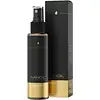What's inside
What's inside
 Key Ingredients
Key Ingredients

No key ingredients
 Benefits
Benefits

 Concerns
Concerns

 Ingredients Side-by-side
Ingredients Side-by-side

Water
Skin ConditioningCyclopentasiloxane
EmollientCyclohexasiloxane
EmollientPhenyl Trimethicone
Skin ConditioningDimethiconol
EmollientPolyquaternium-16
Panthenol
Skin ConditioningPropylene Glycol
HumectantHydrolyzed Wheat Protein
Skin ConditioningHydrolyzed Silk
HumectantPEG-12 Dimethicone
Skin ConditioningHydroxypropyltrimonium Hydrolyzed Wheat Protein
Skin ConditioningLactic Acid
BufferingCetrimonium Chloride
AntimicrobialParfum
MaskingBenzophenone-4
UV AbsorberCI 16185
Cosmetic ColorantBenzyl Salicylate
PerfumingAmyl Cinnamal
PerfumingLimonene
PerfumingCitronellol
PerfumingLinalool
PerfumingGeraniol
PerfumingWater, Cyclopentasiloxane, Cyclohexasiloxane, Phenyl Trimethicone, Dimethiconol, Polyquaternium-16, Panthenol, Propylene Glycol, Hydrolyzed Wheat Protein, Hydrolyzed Silk, PEG-12 Dimethicone, Hydroxypropyltrimonium Hydrolyzed Wheat Protein, Lactic Acid, Cetrimonium Chloride, Parfum, Benzophenone-4, CI 16185, Benzyl Salicylate, Amyl Cinnamal, Limonene, Citronellol, Linalool, Geraniol
Water
Skin ConditioningCetyl Alcohol
EmollientBehentrimonium Chloride
PreservativeStearyl Alcohol
EmollientGlycerin
HumectantCyclopentasiloxane
EmollientPersea Gratissima Oil
Skin ConditioningButyrospermum Parkii Butter
Skin ConditioningTocopheryl Acetate
AntioxidantPropylene Glycol
HumectantCetrimonium Chloride
AntimicrobialCitric Acid
BufferingSodium Glycolate
BufferingSodium Hydroxide
BufferingIsopropyl Alcohol
SolventEthylhexylglycerin
Skin ConditioningTetrasodium EDTA
Phenoxyethanol
PreservativeTrisodium EDTA
Parfum
MaskingLimonene
PerfumingHexyl Cinnamal
PerfumingBenzyl Benzoate
AntimicrobialCitral
PerfumingLinalool
PerfumingWater, Cetyl Alcohol, Behentrimonium Chloride, Stearyl Alcohol, Glycerin, Cyclopentasiloxane, Persea Gratissima Oil, Butyrospermum Parkii Butter, Tocopheryl Acetate, Propylene Glycol, Cetrimonium Chloride, Citric Acid, Sodium Glycolate, Sodium Hydroxide, Isopropyl Alcohol, Ethylhexylglycerin, Tetrasodium EDTA, Phenoxyethanol, Trisodium EDTA, Parfum, Limonene, Hexyl Cinnamal, Benzyl Benzoate, Citral, Linalool
Ingredients Explained
These ingredients are found in both products.
Ingredients higher up in an ingredient list are typically present in a larger amount.
This ingredient is a preservative, antimicrobial, and emulsifier. It is often used in cosmetics for its ability to cleanse, condition, and reduce static.
Cetrimonium chloride is a quaternary ammonium salt, meaning it has a water-soluble structure.
Cyclopentasiloxane, or D5, is a silicone used to improve texture of products and trap moisture.
D5 is considered lightweight and volatile. Volatile means it evaporates quickly after application. Once evaporated, D5 leaves a thin barrier that helps keep skin hydrated.
It is also an emollient. Emollients help soften the skin and prevent water loss. Silicones create a silky texture in products. D5 helps other ingredients become more spreadable.
Studies show D5 is safe to use in skincare products. We recommend speaking with a skincare professional if you have concerns.
Learn more about CyclopentasiloxaneLimonene is a fragrance that adds scent and taste to a formulation.
It's found in the peel oil of citrus fruits and other plants such as lavender and eucalyptus. The scent of limonene is generally described as "sweet citrus".
Limonene acts as an antioxidant, meaning it helps neutralize free radicals.
When exposed to air, oxidized limonene may sensitize the skin. Because of this, limonene is often avoided by people with sensitive skin.
The term 'fragrance' is not regulated in many countries. In many cases, it is up to the brand to define this term. For instance, many brands choose to label themselves as "fragrance-free" because they are not using synthetic fragrances. However, their products may still contain ingredients such as essential oils that are considered a fragrance.
Learn more about LimoneneLinalool is a fragrance and helps add scent to products. It's derived from common plants such as cinnamon, mint, citrus, and lavender.
Like Limonene, this ingredient oxidizes when exposed to air. Oxidized linalool can cause allergies and skin sensitivity.
This ingredient has a scent that is floral, spicy tropical, and citrus-like.
Learn more about LinaloolParfum is a catch-all term for an ingredient or more that is used to give a scent to products.
Also called "fragrance", this ingredient can be a blend of hundreds of chemicals or plant oils. This means every product with "fragrance" or "parfum" in the ingredients list is a different mixture.
For instance, Habanolide is a proprietary trade name for a specific aroma chemical. When used as a fragrance ingredient in cosmetics, most aroma chemicals fall under the broad labeling category of “FRAGRANCE” or “PARFUM” according to EU and US regulations.
The term 'parfum' or 'fragrance' is not regulated in many countries. In many cases, it is up to the brand to define this term.
For instance, many brands choose to label themselves as "fragrance-free" because they are not using synthetic fragrances. However, their products may still contain ingredients such as essential oils that are considered a fragrance by INCI standards.
One example is Calendula flower extract. Calendula is an essential oil that still imparts a scent or 'fragrance'.
Depending on the blend, the ingredients in the mixture can cause allergies and sensitivities on the skin. Some ingredients that are known EU allergens include linalool and citronellol.
Parfum can also be used to mask or cover an unpleasant scent.
The bottom line is: not all fragrances/parfum/ingredients are created equally. If you are worried about fragrances, we recommend taking a closer look at an ingredient. And of course, we always recommend speaking with a professional.
Learn more about ParfumPropylene Glycol is an odorless, colorless liquid. As a humectant, it helps skin retain moisture. It also aids in delivering active ingredients.
Another role of this ingredient is preventing a product from melting or freezing. Propylene glycol also adds antimicrobrial properties to a product, elongating product lifespan.
This ingredient is considered an organic alcohol and commonly added into both cosmetics and foods.
Those with sensitive skin or conditions may develop a rash when using this ingredient.
Learn more about Propylene GlycolWater. It's the most common cosmetic ingredient of all. You'll usually see it at the top of ingredient lists, meaning that it makes up the largest part of the product.
So why is it so popular? Water most often acts as a solvent - this means that it helps dissolve other ingredients into the formulation.
You'll also recognize water as that liquid we all need to stay alive. If you see this, drink a glass of water. Stay hydrated!
Learn more about Water